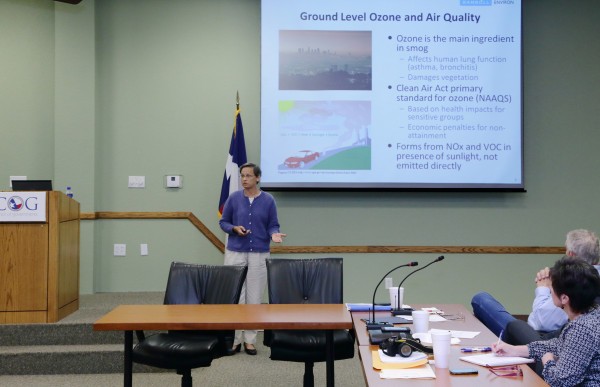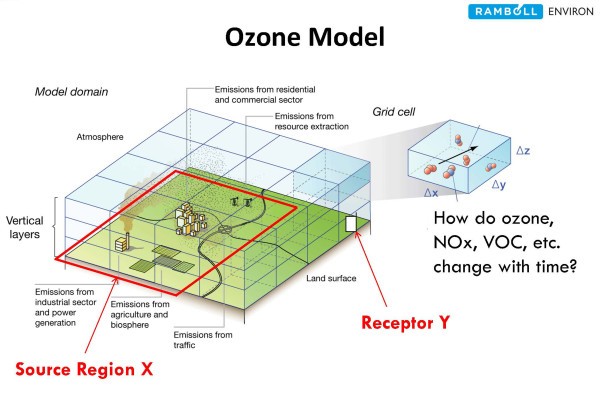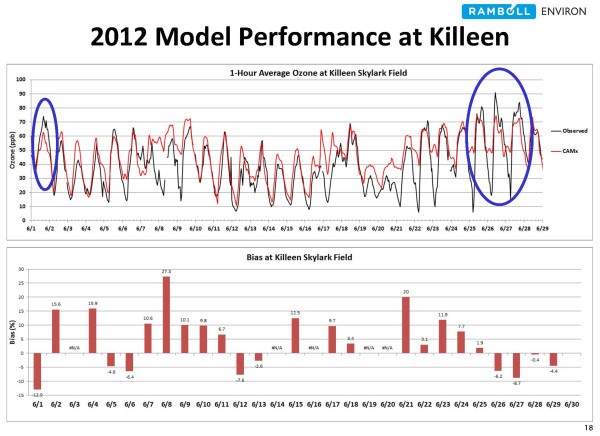The CTCOG Executive Committee met on July 23rd. Dr. Sue Kemball Cook of Ramboll-Environ explained the processes behind ozone formation and described the development of conceptual ozone model for the Killeen-Temple-Fort Hood region.
Ozone formation
Many factors need to be considered in understanding ozone. Vehicle emissions, weather, and emissions that waft in from other localities all must be taken into account. The basic concept is that ozone up high in the stratosphere is good because it acts like a cover and protects the earth from the sun’s rays. However, when ozone is in the troposphere (ground-level, where humans live), the effects are harmful to human health. There are two major precursors needed to form ozone – Nitrogen Oxides (NOx) and Volatile Organic Compounds (VOCs). NOx are present in vehicle emissions and are produced by other combustion processes. VOCs are volatile organic compounds that come from trees and other plants, and also can be generated during certain industrial processes, such as paint or solvent applications. According to Dr. Cook, the area that we can have the most control over is in the amount of NOx generated through human activity – that is, transportation, agriculture, and industrial processes.
Currently, most of Bell County’s NOx comes from the congestion on I35 (heavy traffic and idling of cars in traffic). Most of Milam County’s NOx comes from the Sandow Power Plant. Other sources throughout our region are agricultural equipment and locomotives. The Panda Power Plant in Temple is relatively new and has not yet factored into collected data since it was not in operation in 2012 when the data was collected. However, it will likely impact future data.
Computer modeling
The conceptual ozone model is a three-dimensional computer simulation that estimates where ground-level ozone may form. It can predict volumes of ground level and atmospheric ozone, as well as how weather patterns can transport ozone into and out of our region. The graphic below shows how the model breaks the air and ground into a grid of three-dimensional cells. This allows scientists, planners, and officials to simplify the complex interactions of weather, emissions, sunlight and geography into a manageable set of data.
This chart from page 18 of Dr. Cook’s presentation shows how closely the model data replicates the actual data observed from local ozone monitors. A credible model is crucial for planners and elected officials when they are crafting policies, standards and regulations.
What is the next step?
Why do we measure ozone? The EPA sets limits of acceptable ozone levels known as the National Ambient Air Quality Standards (NAAQS) to improve air quality and minimize the negative health impacts of ground-level ozone. Communities that exceed those limits are said to be in a “non-attainment” status. As part of their mandate, the EPA is required to revisit the imposed limits every five years. The concept is that new technology along with new data will help keep the NAAQS current. The EPA is considering lowering the current standard of 75 ppb (parts per billion) to 65-70 ppb. Showing the ozone trends captured from Killeen, Dr. Kemball-Cook stated that 2014 was the cleanest year in the decade due in large part to cooperative weather. If the cap is lowered or if weather patterns change, there is concern that we could become a “non-attainment” area.
During the discussion period, many subjects were covered such as who installed the air monitoring equipment, why were certain areas selected over others, what is the decision process for lowering the NAAQS, and what activities should we consider to start reducing our NOx. EPA has the authority to set, and possibly modify, the boundaries of the non-attainment area. Further, Bell County may be eligible to apply for a Texas Emissions Reduction Plan (TERP) grant. These are grants available through TCEQ to replace outdated motor vehicle or agricultural equipment in order to reduce emissions from polluting vehicles and equipment.
Download the presentation (PDF file, 2.8mb)
What can YOU do to help reduce emissions and prevent formation of ground-level ozone? We’ve listed several strategies and resources on our Air Quality page.



